|
These
are drawing lessons that make the hard stuff easier. Students gain
confidence doing real observation and expression. No copy work is
involved. No examples are shown in advance, but careful instructions and preliminary practice helps clarify these ideas and helps students feel confident. I remind students that the purposes of practice is to make
things easier and better. Practicing The Self Observed
- Each
day they draw one practice drawing of a self-portrait directly on a
mirror using the type of felt tips used for overhead projectors (these
marks wipe off with moist paper towel). Optionally, students can secure a piece of transparency plastic to the mirror with pieces of tape. This can make it easier to trace drawings onto typing paper. The traced drawings can be developed while looking in the mirror.
- Each day after making a practice self-portrait, finish the period doing figure drawings (see below).
- After
at least five sessions of practicing directly on mirrors, move to using
the mirrors for reference for a self portrait painting that can take
several periods.
- Instead of
giving prior instruction such as how high the eyes are in a face, I ask
the students to tell me how high the eyes are in the face.
Practicing
Three Ways to Draw a FIGURE. Each day, after a self-portrait practice,
practice figures drawing by the three methods below.
- Blinder Buddy(TM) drawing helper practice
Use
Blinder Buddy helper on pencil so the drawing is not seen while edges
(contour) of figure are drawn. Only look under the drawing helper at
when starting a new line.
- INSIDE-OUT GESTURE practice
- Pose the figure in an active athletic pose with slanted and extended arms and legs.
-Add pieces of highly visible tape at each joint of the figure to give structural emphasis to the model.
- Work on large brown or white wrapping paper.
- Use the side of a piece of dark crayon, Conte crayon, or synthetic charcoal. Anything that is very bold.
- Allow absolutely NO OUTLINES
- START IN THE CENTER of body and very rapidly shade in the whole figure with VERY fast gestural hatching (inside-out).
- NEVER LIFT the crayon from the paper. Keep it in CONSTANT MOTION but
vary the pressure. Fill in a bit of the body, move to a leg, to the
head, to an arm, etc., never finishing one part before all parts are
started. Keep building up all parts until all parts are finished.
Finish in two minutes or faster.
- INVISIBLE FIGURE DRAWING
Use
high visibility pink or orange very thin plastic ribbon from building
supply stores (used to mark stakes during construction).
Pose figure in active athletic pose. Wrap with ribbon. Tape it in place.
Draw ONLY the ribbon - not the figure.
SAFETY NOTE: Use
only thin plastic ribbon that can break very easily. Use only with
adult supervision. Do not tie knots. Fasten ribbon with pieces of tape.
|
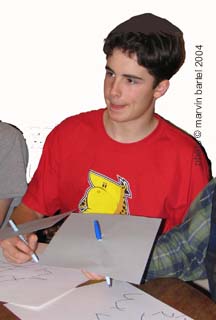 |
Invisible Figure Drawing using Blinder Buddy (TM)
drawing helper to conceal paper during drawing.
I find that blinders can be helpful with any school aged child or adult.
I tell younger children that it is outline practice.
After practice, I allow them to draw the same thing again
without the blinder, but I encourage them look
at the person being observed most of the time.
WHY is this important? Tutoring younger children in blind drawing practice
skills is a way to let them know how we learn to read
our visual worlds carefully in order to draw them better.
We tutor reading, writing, math, etc. By tutoring seeing and
drawing, they learn to visually read, observe,
describe and draw their worlds better.
Children who practice observation skills are less apt
to suffer a crisis of drawing confidence as they mature.
Being more confident, they engage in more self-initiated drawing.
Being more confident, they are less apt to become as
dependent on copying in order to learn to draw.
back to top of article ^^^
Equipment:
Each student needs
- a
mirror about 8 x 10 inches. Get the least expensive mirrors cut by the
local glass company and tape them with duct tape to 9 x 12 inch pieces
of foam core. Hinge another piece of foam core to the top edge with
duct tape so they can stand like an easel in front of the student.
Student assistants can help make these.
- A blinder buddy is a big card on the drawing pencil to hide the drawing
- Some bright ribbon sold to building contractors.
|
Art History:
After
the students have practiced and completed their own expressive original
drawings and paintings, they will have a sound frame of reference and
strong interest in the study of the self-portraits and figure drawings
of famous artists such as Kathy Kollwitz, Frida Kahlo,
Pablo Picasso, Rembrandt, and others. Search others by artist name,
self portrait, and drawing. An Internet image search will find many
examples of famous drawings.
|
The Critique
Process is part of every good art lesson. A good assignment is great,
but a good critique can be an even better way to learn art.
Include a Rubric for this lesson. Testing in Drawing class. Turning in Grades in Art.
ABOVE:
Modeling and drawing Invisible Figure Drawing (cross-contour drawing)
where only the orange ribbon is drawn. Blinder Buddy is used to hide
paper while drawing.
SAFETY NOTE: Use only the very thin plastic ribbon that can break very easily. Use only with adult supervision. Only fasten it with pieces of tape. Do not tie knots.
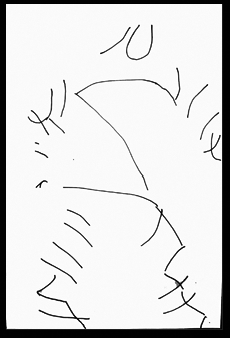 |
An Invisible Figure Drawing
(blind cross contour)
by a 4th grade student.
|
Want to HELP? Have you tried this lesson or parts of this lesson in your class? Send me an email note
with your ideas for improvements, your questions, or other creative
ideas that occurred to you or your students as you worked with this
lesson.
See related art teacher ideas that have been shared on page 2.
A Manikin variation from Shelly Gordon, Glenville, NY
An Art and Science variation from June Covington, DeSoto, Texas
You are invited to share your ideas.
 --- Why do these lessons work? by Marvin Bartel --- Why do these lessons work? by Marvin Bartel
CONTACT
Other Art Lessons and essays by the same author
Teaching The Secrets of Generating Art Ideas: An Inside Out Art Curriculum
Creativity Killers in the art room
How to teach creativity
Conversation Game - generate creative ideas and foster social skills
Advocacy for Art Education in our schools
Dragonfly Innovation Award Winning Drawing Kit
biography of author - contact author
All rights reserved. This page © Marvin Bartel, Emeritus Professor of Art, Adjunct in Art Education, Goshen College. Teachers
many make a single copy for their personal use so long as this
copyright notice and dates are included. Scholarly quotations from this site are permitted with
proper attribution. You may make a link to this site. If desiring a link exchange, link exchanges are only considered for sites that already have a working link to this site. For permission to make copies or handouts of this page, contact author
Posted January 3, 2006. Last updated January 12, 2009
|
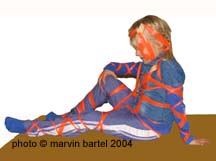

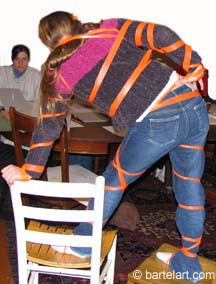
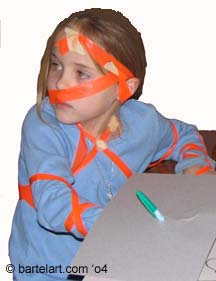

 ---
---